Digital Hair Removal
Challenge
Many dermoscopic images show configurations where the areas of interest (e.g., lesions) are partially occluded by hairs. While such occluders may not be critical for human investigation, they pose major challenges for automatic image analysis method such as segmentation and/or classification.
Digital hair removal
To address this issue, several so-called digital hair removal (DHR) algorithms have been developed [Lee et al., 1997; Huang et al., 2013; Fiorese et al., 2011; Xie et al., 2009; Kiani et al., 2011; Abbas et al., 2011]. Such DHR methods consist of two steps:
- detection of occluding hairs, using various morphological techniques that search for thin and elongated objects in the image;
- removal of detected hairs, using image inpainting methods.
While several DHR methods exist, they are typically challenged by complex morphologies, such as dense, variable-color, curled hair overlaid atop of high-contrast skin textures. A robust DHR method able to detect and remove a wide range of occluding hair morphologies from all pigmented skin lesions is still needed.
Skeleton-based method
We have developed a new DHR method based on the key observation that hairs are best detected at all luminance levels in an image rather than a single level. Following this observation, our method works as follows (see also the figure below):
- reduce the image (a) to a threshold-set representation, following our skeleton image coding method;
- compute thin and elongated gaps at each level, following our gap detection method
- assemble all detected gaps in a single mask image (b)
- filter the mask to find thin and elongated hairs (c,e)
- remove the found hairs using image inpainting (f)
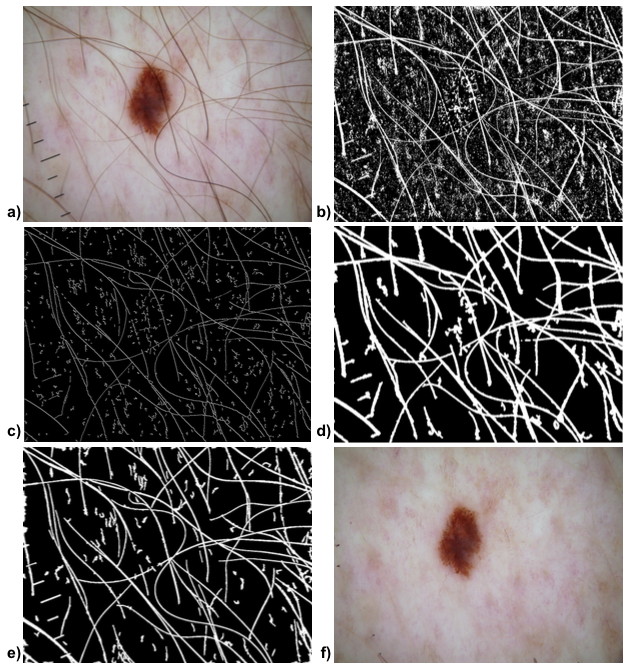
Results and comparison
We have compared our method on over 300 dermoscopy images, acquired with several imaging modalities and from several sources. We compared our results with five recent DHR methods [Lee et al., 1997; Huang et al., 2013; Xie et al., 2009; Fiorese et al., 2010; Abbas et al., 2011]. The results show that our method is able to detect and remove more hair structures than all other methods.
The figure below compares our method with DullRazor [Lee et al., 1997] and Huang et al., 2013
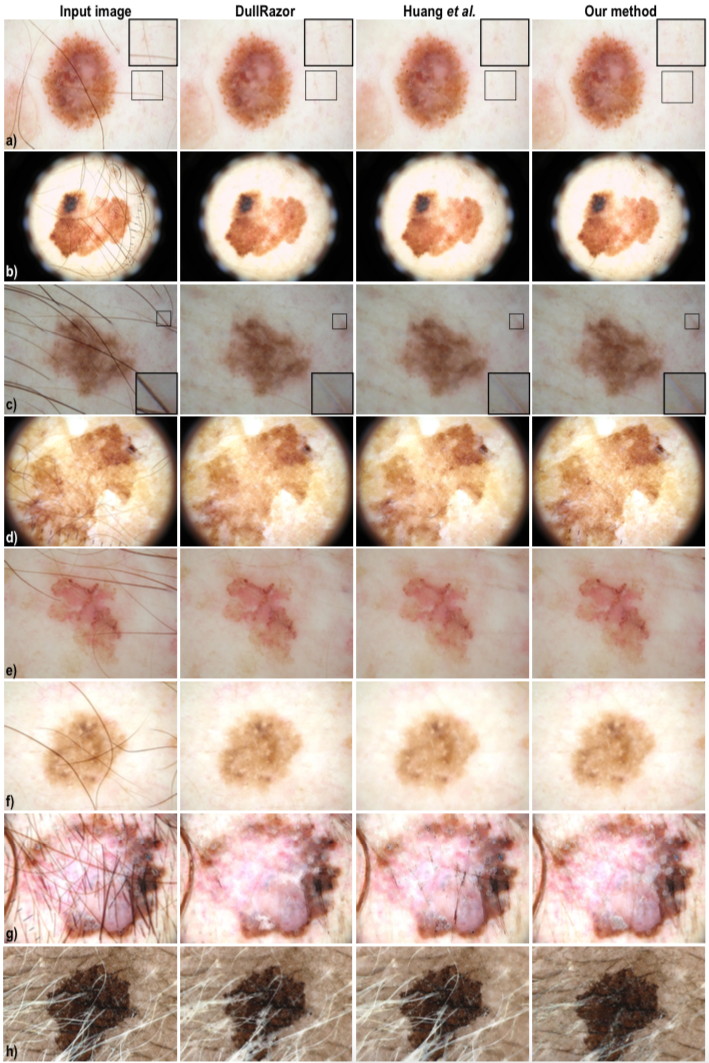
The figure below compares our method with Xie et al., 2009 and Huang et al., 2013

The figure below compares our method with Abbas et al., 2011 and Huang et al., 2013
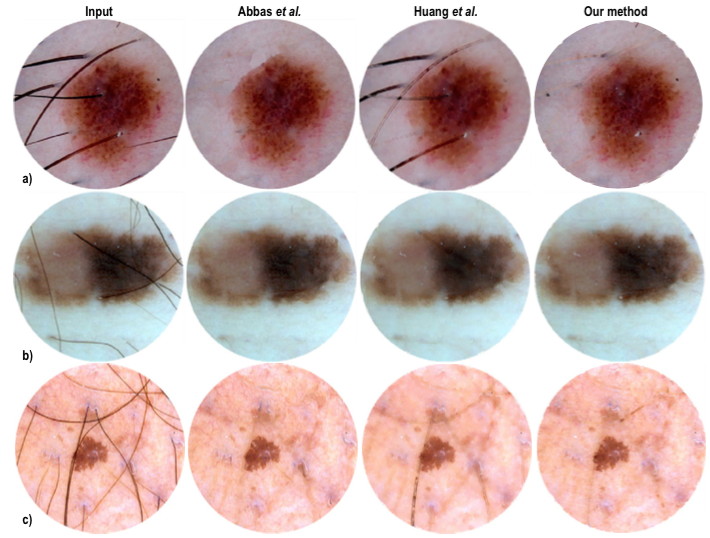
The figure below compares our method with VirtualShave [Fiorese et al., 2011]
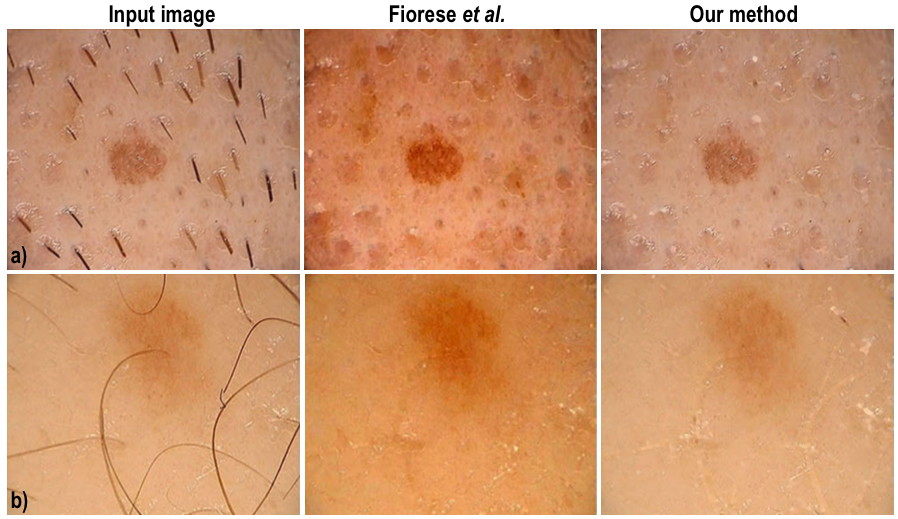
Implementation
Our entire method is implemented in C++ using Nvidia CUDA for the GPU computation of skeletons, distance transforms, and erosions and dilations. For this, we use our GPU skeleton computation platform described here. All in all, our method runs fully automatically and at speeds comparable with, or lower than, the DHR methods tested against, on a modern laptop computer.
Comparison
Our comparison of the proposed DHR method with five recent DHR methods on over 300 images represents, to our knowledge, the most extensive study of DHR methods available in the literature up to date.
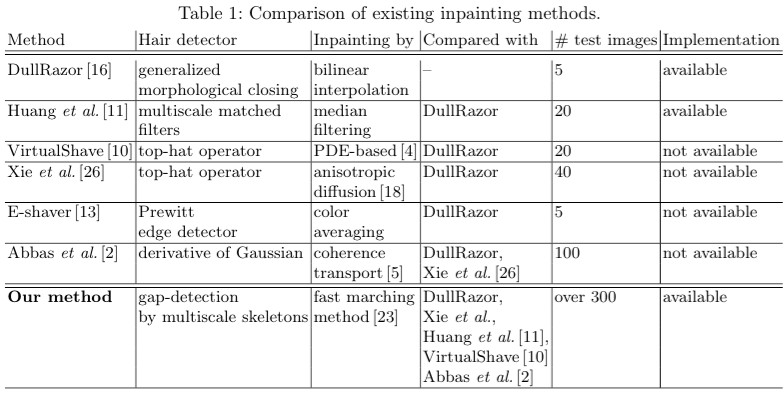
Source code
The implementation of our DHR method (written in C++, requiring Nvidia CUDA and a compatible GPU) is available here
Publications
Efficient and Effective Automated Digital Hair Removal from Dermoscopy Images J. Koehoorn, A. Sobiecki, P. Rauber, A. Jalba, A. Telea. Math. Morphol. Theory Appl. vol. 1, De Gruyter, 2016
References
- Abbas, Q., Celebi, M.E., Garcıa, I.F.: Hair removal methods: A comparative study for dermoscopy images. Biomedical Signal Processing and Control 6(4), 395–404 (2011)
- Fiorese, M., Peserico, E., Silletti, A.: VirtualShave: automated hair removal from digital dermatoscopic images. In: Proc. IEEE EMBS. pp. 5145–5148 (2011)
- Huang, A., Kwan, S., Chang, W., Liu, M., Chi, M., Chen, G.: A robust hair segmentation and removal approach for clinical images of skin lesions. In: Proc. IEEE EMBS. pp. 3315–3318 (2013)
- Kiani, K., Sharafat, A.R.: E-shaver: An improved dullrazor for digitally removing dark and light-colored hairs in dermoscopic images. Comput. Biol. Med. 41(3), 139–145 (Mar 2011)
- Lee, T., Ng, V., Gallagher, R., Coldman, A., McLean, D.: Dullrazor : A software approach to hair removal from images. Comput. Biol. Med. 27(6), 533–543 (1997)
- Xie, F., Qin, S., Jiang, Z., Meng, R.: PDE-based unsupervised repair of hair-occluded information in dermoscopy images of melanoma. Comp. Med. Imag. Graph. 33(4), 275–282 (2009)
